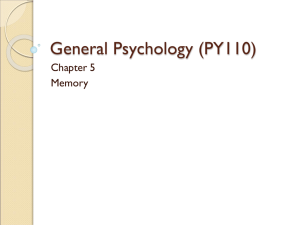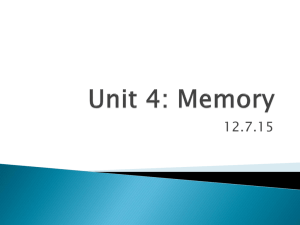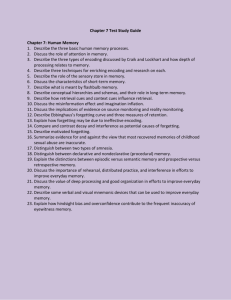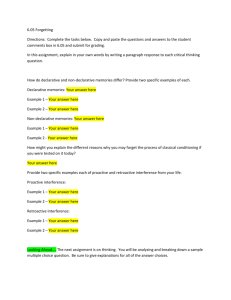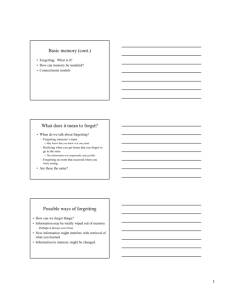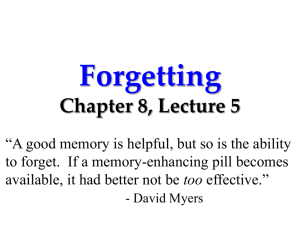Chapter 10
advertisement
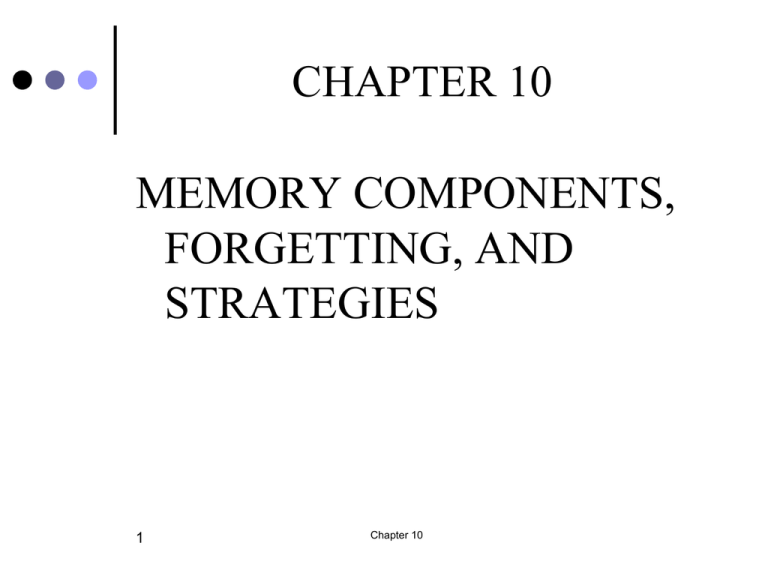
CHAPTER 10 MEMORY COMPONENTS, FORGETTING, AND STRATEGIES 1 Chapter 10 Discussion Assignment Read the following stories in Motor Control text: The Keypad (pages 205-7) Like Riding a bike (pages 219-221) H.M. (pages 223-224) 2 Be able to lead a small or large class discussion over these stories. This will be student led discussion. Chapter 10 INTRODUCTION •Structure of memory •What are the causes of forgetting? •What can one do to decrease the amount of forgetting? •What can one do to increase how much one remembers? 3 Chapter 10 MEMORY Retention or remembering Capacity that permits humans to benefit from past experiences (Tulving, 1985) Related to every situation and skill we perform. 4 Chapter 10 TERMINOLOGY & MEMORY STUDY Motor memory + Verbal Memory = Memory Retention and Forgetting Retention refers to what we remember Forgetting is a retrieval problem 5 Chapter 10 Memory Structure Part of memory is oriented to events just occurred (short term memory) Part of memory is related to events in the past (long term memory) Memory then is usually presented as representing these two components. Short term Long term 6 Chapter 10 Two-components of Memory 7 Two Components of Memory Working or short term memory Permanent or long term memory Chapter 10 WORKING MEMORY Referred to a perceptual or short-term Associated with sensory, perceptual, attention, and short-term processes. Plays a critical role in decision making, problem solving, movement production, and evaluation Working memory serves as interactive workspace Duration (length of time info will remain in working memory) • Use info or lose the info! • Hold info for only 20-30 sec • Recall the following set of words in activity I Capacity (amount of info that resides with working memory) • experience & meaningfulness increase capacity • Recall the following set of words in activity II • Seven +/- 2 items (Miller) Recall the following numbers in activity III • Increase size of items recalled depends on chunking continued 8 Chapter 10 Recall the following pairs of words Stone/Grip Read/Spam Real/Fetter Phony/Confer Phone/Coal Mess/Bud Miss/Suppose 9 Chapter 10 Recall These Word Bench/Curl Sit/Reach Love/You Young/Old Fat/Skinny Touch/Toe Muscle/Nerve 10 Chapter 10 Recall the following set of two numbers in order!! 36 10 97 85 08 10 04 24 11 Chapter 10 WORKING MEMORY Processing Activities • Manipulates information to solve specific movement problem • Manipulates information to perform the goal of movement • Manipulates information for storage in permanent memory 12 Chapter 10 LONG-TERM MEMORY It is what we think of when we hear the term memory Duration of information storage is permanent • Forgetting is a retrieval problem. Capacity of information storage is unlimited • Studying how one organizes information in long term memory is of great importance. Continued 13 Chapter 10 Types of Information Stored in Long Term Memory Procedural memory enables us to know “how to do” the skill. Perform the skill (e.g., know how to do the skill!) How to drive a vehicle or car ! How to put a model airplane together! Declarative (What to do!) Should be able to describe it I need to turn left at the stop light! Episodic Remembering some experience in terms of time & context Last Tuesday at this intersection there was a car accident. I better look twice when crossing! Semantic General knowledge about the situation and skill The diver attempted a left hand turn and was hit by an on coming car. 14 Chapter 10 Knowing what to do and Doing it! Declarative Knowledge 15 What to do! Can verbalize it Able to describe it when ask but may not be able to do it! Implicit Chapter 10 Procedural Knowledge How to do! Able to do it but might not be able to describe it! Explicit Experienced Versus Inexperienced Performers 16 Studies demonstrate that experienced performer’s declarative and procedural knowledge is greater than inexperienced performers. Chapter 10 Remembering & Forgetting Encoding Transforming information to be remembered into a form that can be stored • Storage – process of placing information in long term memory • Rehearsal –enables humans to transfer information from working to long term memory Retrieval 17 Process of searching long term memory that must be processed and used in order to perform the task Chapter 10 ASSESSING REMEMBERING AND FORGETTING Explicit Memory Tests (Let me show you how and/what I can do it!) Recall test (produce a movement with little or no cues – “Perform the skill I just showed you!”) Recognition test (gives us an understanding of what information was actually stored even though cues or aids are needed) Implicit Memory Tests (Let me tell you how and what to do it?) Verbally describe what to do in the situation. It is not uncommon for people to be able to describe the procedure or how to perform and not be able to perform it! 18 Chapter 10 CAUSES OF FORGETTING Trace Decay Proactice interference Time factor of working memory Activity that occurs prior to the presentation of the information that is to be remembered Retroactive interference Activity that occurs during retention 19 Chapter 10 Fact!!! Forgetting is the greatest when there is similarity between what is remembered and the interfering activity. e.g. tennis serve and overhand throw 20 Chapter 10 When is forgetting the greatest? Attempt to remember the following terms in order they are presented: Spud Nut Spur Now Rob Kite 21 Chapter 10 Rib Kick Spun Kind Spoon 22 Recall Chapter 10 Professional Implications that Apply to Memory After you give a demonstration of the skill of what to do or how to do the skill, you should do what! Do not describe or demonstrate what not to do before you give a demonstration of what to do! If people ask questions after your demonstration, what should you do? Physically practice immediately Repeat the demonstration If the players can describe to you the play, they most certainly did remember it. Yes or NO? 23 Chapter 10 spud, nut, spur, now, rob, kite, rib, kick, spun, kind, spoon Notice the every other term was similar and you may have remembered one but not both as you go along the line. 24 Chapter 10 Trace Decay Trace decay applies to short term memory not long term memory It is likely that forgetting involves misplacing of information in long term memory rather than it decaying or deterioration due to passage of time or use. 25 Chapter 10 Memory Card Game Separate your cards into two stacks. One stack is black other red. Shuffle the black stack and place the cards face down. Wait for further instructions. Recall the black cards from highest to lowest. Once you can recall the cards. Turn the cards over face down and wait for further instructions. 26 Chapter 10 Proactive Interference There is an activity just prior to the presentation of information to be remembered. Major reason why the activity may causes problems in working memory is the activity caused confusion. Greatest affects on working memory occurs when the activity and what is to be remembered are similar. Effects of proactive interference on long term memory is unknown. • If we actively rehearse the task, the activity it has little effect 27 Chapter 10 Proactive Interference PAS T you What learned in past about the skill. Old Learning PRESENT What you are presently learning about the skill. FUTURE What the client/student will do in the future. Interferes Old Learning Interferes Proactive interference occurs when current information is lost because it is mixed up with previously learned, similar information. Earlier information projects itself forward (proactive) and interferes with what we try to learn next. Chapter 10 Proactive Interference & Judging Research has indicated that judging previously seen elements biased the judges evaluations when the skill was performed differently from the previous observation (Memory article by Ste-Marie, Valiquette, and Taylor (2002). E.g., I have two ice skaters. The first skater performs the required skills in the routine in a traditional style. Then the second skater performs the traditional skills in a unique and different manner other than how it is to be performed traditionally. The first skater’s performance will bias the judge’s score of the second skater. 29 Chapter 10 Card Sorting Task The cards have been ordered by color (red or black) and suit. There are 6 red and black cards. For example, if your ace is a diamond or heart then your red cards are 1,3,5,7,9,11 and black cards are 2,4,6,8,10, 12. I want you to turn over all your red cards in order than black cards in order if you your ace is a diamond or heart. I want you to turn over all your black cards 6 times in arrow than turn over your red card in order. This activity will be timed!! Once completed turn your cards face down. Wait for further instructions!! 30 Chapter 10 Retroactive Interference An activity occurs during the period of time we are needed to remember the movement. Working memory is greatly affect by the degree of similarity between the interfering activity and the movement to be remembered. • People can remember the order the way they learned it but if they are ask to recall it differently than retention is impaired. Retroactive interference greatly affects memory if activity and movement to be remembered exceeds our working memory capacity (Miller’s Law) 31 Chapter 10 Retroactive Inteferene PAST PRESENT Interferes FUTURE New Learning Interferes New Learning Retroactive interference occurs when present information works backwards to interfere with earlier information. It occurs when previously learned skills is lost because it is mixed up with new and somewhat similar information. 32 Chapter 10 Reducing the Retrieval Problem Associated with Motor Skills One should use a location-type strategy in recalling. Instructions and demonstrations should concentrate on critical location points of the limb movement. • E.g. 3 O’clock; 6 O’clock; 12 O’clock • Card sorting task • Reshuffle the 12 remaining cards and place them face down making a circle that is associated with a face of the clock. • Now complete the task as before with only 12 cards staring with one and finishing with 12. Turn the cards over and wait for further iinstructions. Most people can remember the beginning and end of the movement (Primacy-recency effect) Moment end points are better recalled than distance movements. Different positions of the limb movement should be emphasized. Body part cues should be emphasized. Meaningfulness of the movement 33 Chapter 10 FORGETTING AND LONGTERM MEMORY SUMMARY Trace decay, retroactive, and proactive interference affects working memory more than long-term memory Continuous motor skills are more resistant to forgetting (verbal coding is small) due to repetition. Procedural skills (primacy-recency effect) are easily forgotten then discrete skills Forgetting in long term is a retrieval problem. 34 Chapter 10 STRATEGIES THAT ENHANCE MEMORY PERFORMANCE Increase the meaningfulness Intention to remember Subjective organization (chunking) Practice-test context similarity 35 Chapter 10 How do we make a task meaningful? Visual imagery Provide the learner or client with a useful image of the movement (3 Fs of performing) Verbal label Use verbal labels and cues that related to position during the movements • Up together, down together and through! • Pow-Pow-Pow • Useful in young children under the age of 7 as well as adults Relate the movement to what they will be doing in the game, sport, or real life skills 36 Chapter 10 Intended versus unintended Movement to Remember Intended Unintended If you know in advance that you will be required to remember the movement there is great probability you will remember it! E.g., study guides; highlighting a certain movement; “this part of movement is the most important”. Unexpected recall test over the movement (pop quiz) Intended versus unintended! Advanced knowledge will increase the effort of practice and result in better remembering 37 Chapter 10 Subjective Organization Grouping or organizing the information into units rather an pieces Organize material based on its meaningfulness • Stoke and Parkinson’s patients have difficulty in subjectively organization strategies. • Bob Woodruff • At the novice stage, learner approaches movement as comprising a lot of parts. • At the experienced stage, learner organizes the parts into units (chunking). 38 Chapter 10 39 Chapter 10 Subjective Organization Recall the following letters in their exact order: Recall the following letters in their exact order: 40 L-W-I-C-X-N-Q-S-B-H-Y-O X-Y-Z-A-B-C-N-B-A-H-O-W-K-E-Y Chapter 10 Practice-Test Context Relationship between the practice and test context…. More similar, more is remembered In closed skill situations it is know as encoding specificity principle…. amount of similarity between the practice and the test context. 41 Chapter 10 SUMMARY Memory has two components Working memory Long-term memory Forgetting relates to factors of trace decay, interfering activities and type of skill (procedural versus continuous) Remembering is related to movement location strategies, end points, and meaningfulness How well one remember is related to verbal cueing, intention, subjective organization, and practice-context similarity 42 Chapter 10

